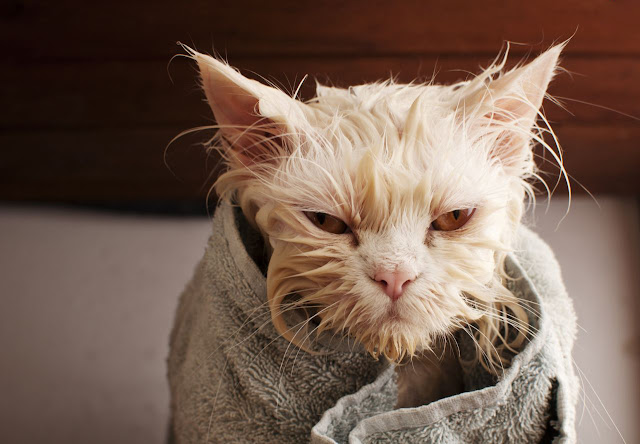Can you bathe a cat and when should you? Let’s take a look at five times you should wash your cat, and how to make cat baths as stress free as possible.
 |
| https:/www.pets4homes.co.uk/images/articles/2714/bathing-a-cat-with-as-little-trauma-as-possible-5519a04f35530.jpg |
1. Your cat is a Sphynx or other hairless breed
Sphynxes need to be bathed once every week or so in order to get rid of the oils that accumulate on their skin. If they’re not regularly bathed, they can develop cat acne, and the feel of their oily skin may make petting and affection much less enjoyable for you.
2. Your cat has ringworm
This fungal infection requires medicated baths in order to eradicate. Your vet or groomer can teach you how to give these baths in a way that’s safe for you and your cat.
3. Your cat has fleas
Baths aren’t necessarily needed for cats with fleas, but you may need to bathe cats with severe infestations or flea allergies. Also, if your cat is too young for regular flea products, a bath is the only choice to get the fleas, and their eggs, off your cat.
4. Your cat got into something nasty
Sometimes cats get into things they can’t get off their own fur. Or, what they got into may be toxic or smell awful, like skunk spray. In this case, a bath is the best solution.
5. Your cat is arthritic or obese
Cats with arthritis or cats who are very fat have trouble cleaning themselves and may need your assistance to do so. While you’re helping your fat cat get to a normal weight, cleaning him in order to avoid urine scald and other problems will be a huge help. Arthritic cats may actually appreciate the warm water.
Alternatives to cat baths
In some cases, you can just clean your cat using unscented, hypoallergenic wipes or dry shampoos rather than giving full-scale cat baths. But keep in mind that some cats won’t like being sprinkled with waterless shampoos any more than they’d like being bathed. Make sure the dry shampoos are good for dry or sensitive skin if your cat has either.
When my cat, Siouxsie, was severely arthritic, she appreciated being wiped down in places she was having a hard time reaching.
How to give your cat a bath
1- Prepare: Get all your tools together: shampoo, towels, a pitcher or detachable shower head, lots of towels and, of course, treats to reward your cat for her patience.
2- Get your bathing site together: Use your sink or a dish tub in your bathtub. Lay a towel, non-slip bath mat or other surface that your cat can grip onto, in the bottom of your sink or dish tub. Fill with a few inches of warm water. Make sure the water isn’t too hot by testing the temperature on the inside of your forearm.
3- Get the cat: Gently place and hold your cat in the sink, using the pitcher to wet down your cat’s coat. Don’t pour the water over your cat’s head. Lather up: Use a hypoallergenic, unscented shampoo specifically designed for pets. If your cat has ringworm, your vet may give you a medicated shampoo to use.
4- Rinse: Thoroughly rinse the shampoo off, using a pitcher or a showerhead. If you’re using a showerhead, use a low flow rate so you don’t scare your cat. If you’re using a sink, use the sprayer. Again, test the water temperature before using the sprayer or showerhead on your cat.
5- Dry: Use a series of towels to thoroughly dry your cat. Don’t use a blow dryer unless your cat is already familiar with it. Put your cat in a nice, warm place to finish drying off.
Tell us: Have you ever bathed your cat? What’s your advice for giving a cat bath?









0 comments:
Post a Comment